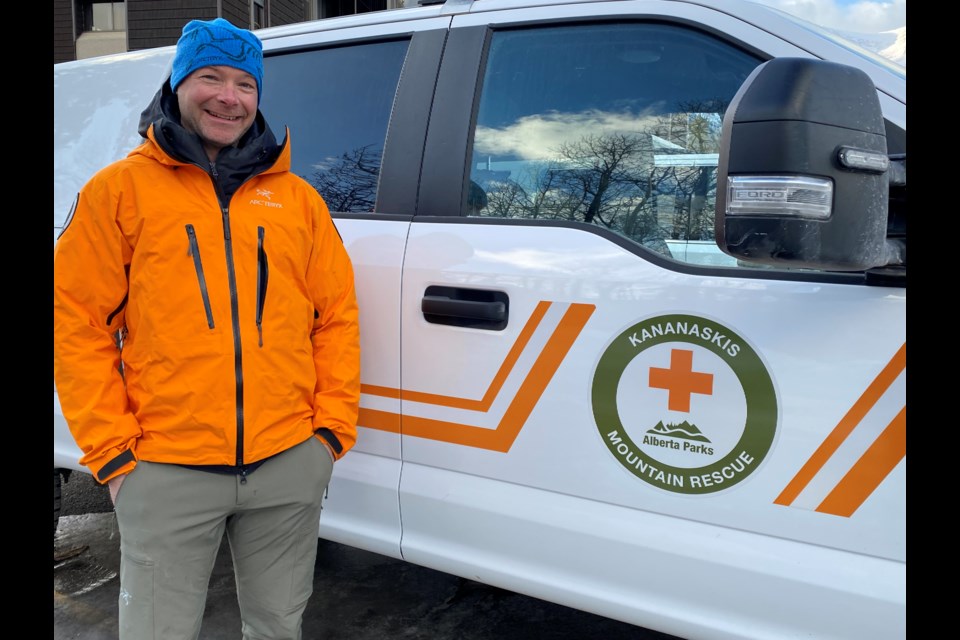KANANASKIS COUNTRY – Its name may have changed, but the former Kananaskis Country Public Safety (KCPS) program pledges to provide the same essential service to the region under its new, more precise title.
Jeremy Mackenzie, mountain rescue specialist and team leader of what is now known as Kananaskis Mountain Rescue (KMR), said the change has been in discussion for a number of years, for two main reasons.
“The phrase ‘public safety’ is quite broad, and it doesn’t necessarily describe what we do terribly well,” he said. “Public safety, in the greater realm of things, can include things like anti-terrorism, which is not what we do.”
There are four parts to KMR’s mandate, the first and most important of which is to provide 24/7 backcountry search and rescue services in the Kananaskis region on behalf of the province.
Other responsibilities include avalanche forecasting and mitigation work; providing training to rescue specialists and technicians, as well as conservation officers and park rangers; and public outreach and education.
The program is dispatched from the Kananaskis Emergency Services Centre [KESC], home to the region’s fire service, however, the organizations are two separate entities capable of responding to different emergency situations – sometimes together, but often apart.
KESC also handles rescues in the front country, where KMR’s mountain rescue specialists have different equipment and skill sets which enable them to access and navigate remote, mountainous terrain safely.
But over the years, their shared headquarters and similar responsibilities have been the cause of some confusion between the two groups, particularly with those not as familiar with the region.
“There are other entities which we work with, and within that have similar names or acronyms, and Kananaskis Emergency Services is a good example of that,” Mackenzie said. “We would frequently get confused with them in our head offices in Edmonton and so on.
“We just thought this was a good opportunity to be a bit more descriptive of what exactly it is we do on the landscape, and that also helps to avoid some of the confusion that has happened for a long, long time.”
Nothing has changed with the program’s mandate, he added. Besides the name, the only other adjustment is to their logo, which has different text but remains recognizable by its orange cross and Alberta Parks insignia.
“We’ve also done a little bit of outreach and education with our partners and stakeholders, as well as with the public to communicate the change,” said Mackenzie. “But we’re off and running.”
With 4.2 million visitors to K-Country in 2022 – down from five million-plus in the two years prior – Mackenzie noted there were fewer calls made to the former KCPS than in its 10-year average of 360-380, with 306 in total.
In 2020 and 2021, when visitation was at its highest during the COVID-19 pandemic, there were around 450 calls per year.
“That was definitely taxing on our services, but we were still able to manage it. I think if that was to go on for longer periods of time, we would need to adjust it by having a larger staff to be able to manage that call volume,” said Mackenize. “Now we’re back to a more normal pace.”
Despite the number of calls in the region being down, the number of fatalities rose to 16 in 2022, compared to 10 in 2021. The majority of those were fatal drownings.
However, the average number of fatalities does not necessarily correlate with the number of calls in any given year, Mackenzie said.
“It’s really hard to predict. Some years, like last year, we have a more than average number of drownings, and some years, we have a more than average number of scramblers who fall and pass away from injury.”
The mountain rescue program receives about two-thirds of its call volume from May through to the end of September, when visitation to K-Country is typically at its highest with hikers, cyclists, paddlers, climbers, sightseers and others flocking to the area.
Since then-premier Peter Lougheed’s establishment of Kananaskis Country in 1978, visitation has steadily increased to the mixed land-use region, which includes provincial parks, provincial recreation areas, wildland provincial parks, ecological reserves and Crown land.
It was not long after its establishment, and with the development of new trails and infrastructure, that the province recognized the need to deploy a professional rescue service in the area.
In 1979, K-Country’s own specialized search and rescue service was born, modelled after the Parks Canada Mountain Safety program that is still in use today.
The KMR program currently includes five mountain rescue specialists, 17 local and regional conservation officers and park rangers, and several dispatchers.
The Local Journalism Initiative is funded by the Government of Canada. The position covers Îyârhe (Stoney) Nakoda First Nation and Kananaskis Country.




